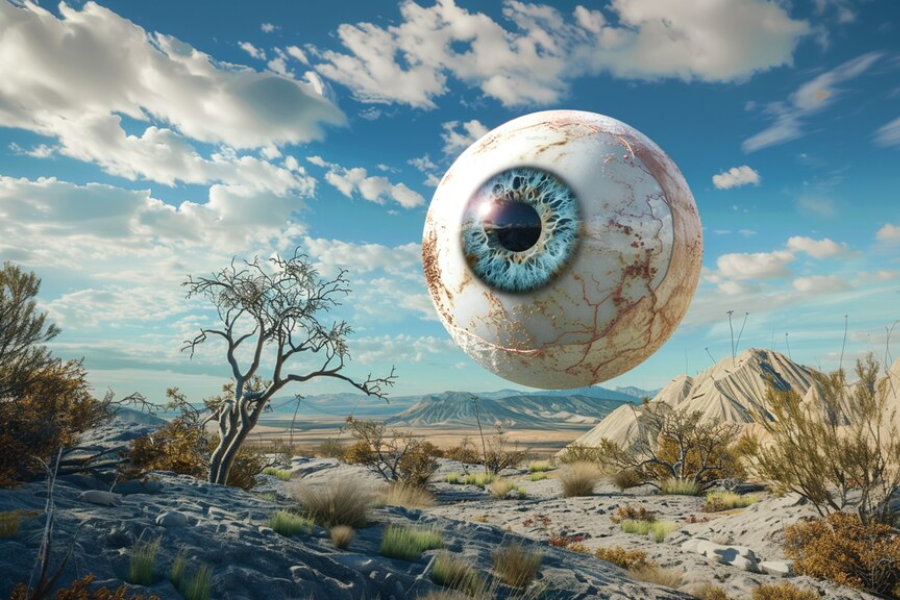MidJourney Spherical Distortion: A New Dimension in Digital Art and Photography
In the ever-evolving world of digital art and photography, new techniques are constantly emerging to reshape our perception of visual media. One such captivating method is spherical distortion—a technique that warps images as though they are viewed through a spherical lens. This method transforms ordinary scenes into immersive and surreal experiences, offering a fresh perspective that enthralls viewers. Known as “MidJourney Spherical Distortion,” this technique brings a unique artistic touch to visual media, adding depth and intrigue to digital art and photography.
Introduction to Spherical Distortion
Spherical distortion is a visual effect that manipulates an image as if viewed through a spherical lens. This technique can vary in intensity, from subtle adjustments to dramatic warping, allowing for a range of artistic expressions. By altering the perception of depth and space, spherical distortion can imbue images with a three-dimensional quality, creating a sense of immersion and surrealism that captures the viewer’s imagination.
Historical Context of Spherical Distortion
The concept of altering images to enhance depth is far from new. Historically, artists and photographers have used various lenses and techniques to achieve distinctive visual effects. The fisheye lens, for instance, produces a similar type of distortion, curving straight lines and expanding the field of view. However, the digital age has revolutionized this technique by introducing advanced tools and software that enable precise and customizable spherical distortions. This advancement has significantly broadened the creative possibilities for artists and photographers alike.
The Science Behind Spherical Distortion
To understand spherical distortion, one must grasp the basics of optics and image processing. When light passes through a spherical lens, it bends in a manner that distorts the image. This bending, known as refraction, results in straight lines curving and objects appearing stretched or compressed based on their position relative to the lens.
Optical Principles
In traditional photography, lenses with spherical elements naturally produce this distortion. Digital art, on the other hand, relies on software algorithms to replicate these optical principles. By applying mathematical transformations to an image’s pixels, digital artists can recreate the bending and warping effects of spherical lenses with greater control and precision.
Computational Techniques
Modern image processing software, such as Adobe Photoshop, GIMP, and various specialized plugins, offer tools for applying spherical distortion. These tools use algorithms to adjust pixel positions based on spherical lens models. Artists can fine-tune parameters such as the sphere’s radius, distortion strength, and focal point, allowing for a highly customizable distortion effect.
MidJourney Spherical Distortion: A Creative Tool
“MidJourney Spherical Distortion” refers to the application of spherical distortion in different stages of the creative process. This technique can be utilized at various points, from initial concept development to final editing, to infuse images with a unique and captivating aesthetic.
Initial Concept Phase
During the initial concept phase, spherical distortion can be applied to rough sketches or preliminary photographs to explore different visual ideas. This early application allows artists to see how distortion affects their subjects, inspiring new compositions and visual narratives that might not have emerged from traditional perspectives.
Creation Phase
In the creation phase, spherical distortion becomes a powerful tool for refining the final artwork. Artists can apply the effect selectively, distorting certain areas of the image while leaving others intact. This selective application can highlight specific elements, create a sense of motion, or add complexity to the visual story.
Final Editing Phase
In the final editing phase, spherical distortion can be fine-tuned to enhance and polish the artwork. Artists can adjust distortion parameters to achieve the ideal balance between realism and surrealism. Final adjustments to colors, contrasts, and lighting can further complement the distorted elements, resulting in a cohesive and visually striking piece.
Applications of MidJourney Spherical Distortion
MidJourney Spherical Distortion is versatile and applicable across various fields of digital art and photography. Its adaptability makes it a valuable tool for artists aiming to push the boundaries of traditional visuals.
Digital Art
In digital art, spherical distortion can be used to craft fantastical landscapes, abstract compositions, and imaginative portraits. Artists can experiment with different levels of distortion to evoke emotions, convey themes, and encourage viewers to interpret the artwork in diverse ways.
Photography
Photographers can use spherical distortion to infuse their images with a creative twist. Whether capturing urban environments, nature, or portraits, this effect can transform ordinary photographs into extraordinary pieces of art. For example, a cityscape viewed through spherical distortion might appear as a futuristic metropolis, while a portrait could take on an ethereal quality.
Graphic Design
Graphic designers can integrate spherical distortion into their projects to create striking visuals for advertisements, websites, and multimedia presentations. The distinctive look of this distortion can help brands stand out and leave a memorable impression on their audience.
Film and Animation
In film and animation, spherical distortion can be employed to create special effects, enhance storytelling, and build immersive worlds. Animators can use this technique to simulate character perspectives, craft dynamic transitions, or infuse scenes with a surreal atmosphere.
Techniques for Creating Spherical Distortion
Achieving spherical distortion requires a blend of artistic vision and technical skill. Several techniques and tools can assist artists in achieving the desired effect.
Using Software Tools
Software tools such as Adobe Photoshop and GIMP offer built-in filters and plugins that simplify the application of spherical distortion. These tools allow artists to adjust parameters like radius, intensity, and focal point. Online tutorials and resources can provide additional guidance on using these tools effectively.
Custom Algorithms
For those with programming expertise, custom algorithms can be developed to achieve specific types of spherical distortion. Using programming languages like Python and libraries such as OpenCV, artists can create tailored distortion effects that align with their artistic vision. This approach offers the highest level of customization but requires a solid understanding of programming and image processing.
Combining Techniques
Often, the best results are achieved by combining multiple techniques. Artists may start with a basic distortion filter and then refine the effect using custom algorithms or manual adjustments. This hybrid approach allows for greater control and precision in achieving the desired look.
Artistic Considerations
While the technical aspects of spherical distortion are important, artistic considerations play a crucial role in creating compelling artwork.
Composition and Balance
Spherical distortion alters the composition by bending lines and shapes. Artists must consider how these changes impact the overall balance of the piece. Strategic placement of distorted elements can create a harmonious and dynamic composition that engages viewers and enhances the visual narrative.
Color and Lighting
Color and lighting are fundamental to any artwork. When applying spherical distortion, artists should consider how the effect interacts with these elements. Adjusting colors and lighting to complement the distortion can result in a more cohesive and impactful visual experience.
Viewer Perception
Understanding how viewers perceive and interpret distorted images is crucial for effective storytelling. Spherical distortion can evoke a range of emotions and reactions, from curiosity and wonder to disorientation and unease. Artists should be mindful of the intended message and how the distortion supports or enhances that message.
Case Studies and Examples
Examining case studies and examples of MidJourney Spherical Distortion provides valuable insight into the creative possibilities of this technique.
Fantastical Landscapes
In digital art, spherical distortion is often used to create fantastical landscapes that defy the laws of physics. Artists can warp natural elements like mountains, rivers, and skies to craft surreal, dreamlike environments. These landscapes invite viewers to explore and immerse themselves in otherworldly scenes.
Abstract Compositions
Abstract compositions benefit greatly from spherical distortion. By bending and twisting shapes and colors, artists can create dynamic and fluid visuals that challenge traditional notions of form and structure. These compositions often convey a sense of movement and energy, captivating viewers with their complexity and beauty.
Portrait Photography
In portrait photography, spherical distortion can add a unique artistic touch to the depiction of the human face. Subtle distortions can enhance features, create depth, or add an ethereal quality to the portrait. More dramatic distortions can transform the subject into a surreal and otherworldly character.
Urban and Nature Photography
Urban and nature photography can also benefit from spherical distortion. In urban photography, the effect can turn cityscapes into futuristic visions, emphasizing the scale and geometry of buildings. In nature photography, spherical distortion can create immersive landscapes that draw viewers into the scene, highlighting the beauty and majesty of the natural world.
Conclusion
MidJourney Spherical Distortion is a powerful and versatile technique that opens up new creative possibilities for digital artists and photographers. By warping images as if viewed through a spherical lens, this effect can transform ordinary visuals into extraordinary works of art. Whether used to enhance depth and perspective or to create surreal and fantastical scenes, spherical distortion captivates viewers and offers a fresh way of seeing the world. As digital art and photography continue to advance, techniques like spherical distortion will play an increasingly vital role in pushing the boundaries of creativity, providing artists with new tools to craft unique and memorable visual experiences.






